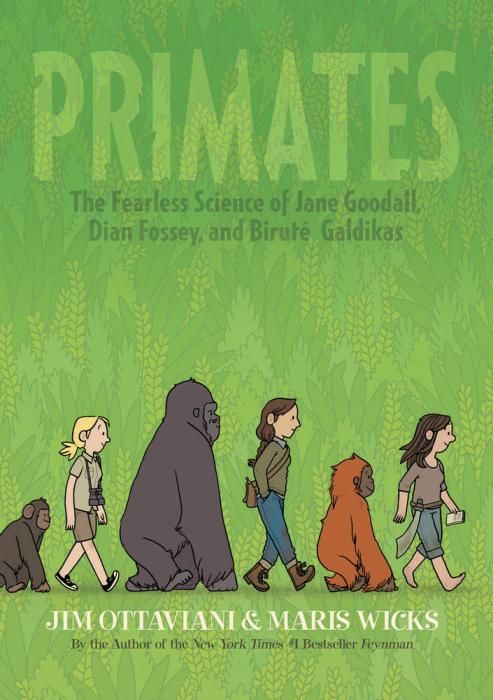Within the first few pages of "Primates: The Fearless Science of Jane Goodall, Dian Fossey, and Birute Galdikas" by Jim Ottaviani and Maris Wicks, I found myself hooked. Not only that, but I reflected back to a similar age as young Valerie Jane Goodall, who is the first of the brilliant ladies to greet the reader in this book.
As a young child, I remember going over to my elderly neighbor's house and spending mornings chatting with her and drawing for her. Her name was Martha Daniels and she was the closest thing I ever had to a third grandmother. She also presented me with a publication called "National Geographic." That magazine blew my five-year-old mind and left an indelible mark on me. I'd seen apes and alligators on TV and in the zoo, but those photos in "National Geographic" transcended anything else. They fostered my love for wildlife and especially nurtured my interest in our closest wild relatives.
I've read a fair bit about Jane Goodall and Dian Fossey and even a tiny bit about Birute Galdikas, but never quite enough. Imagine my joy at finding comics and primates -- with a dose of "National Geographic" history -- thrown my way in the form of "Primates." Following some of the adventures of Goodall, Fossey and Galdikas (also known as Leakey's Angels on account of their having been hand-selected by archaeologist Louis Leakey to study great apes with the intent of discovering key moments in human evolution) the graphic novel is deceptively educational, but filled with biographical info transposed upon a first-person point of view for each of Leakey's Angels.
Ottaviani admits that some embellishments and adjustments were made to the story to provide more intrigue and excitement while also tying the ladies' stories more tightly together. Each of Leakey's Angels is given a portion of "Primates" to tell her story of meeting Leakey, finding inspiration in her mission and the drive to continue. Splices of life are intermingled with journalistic accounting, all of which moves "Primates" along at a surprising rate. The writer presents each story in first person, and Ottaviani does a nice job of distinguishing each lady through her phraseology.
Wicks matches nicely to Ottaviani's vocal attunement. While there is a marked contrast between the photography from "National Geographic" and the style being used by Maris Wicks in the pages of "Primates," there is absolutely no mistaking that Wicks is drawing chimpanzees, gorillas and orangutans instead of indiscriminate apes. Among each of the species, Wicks provides markings and distinction, just as she does among Leakey's Angels (also known as the Trimates). Through it all, Wicks' storytelling is deceptively simple, like R. Kikuo Johnson's work on 2012's "The Shark King." Unlike that book, however, this book is measured by its direct translation of reality into a more animated format. A comic book centered on the lives of three of this century's greatest zoological and ethological pioneers could easily be rendered sterile and clinical. Wicks dumps that choice by the wayside and makes "Primates" a book that can easily hook readers of any age.
"Primates" is a fine example of what comics can deliver. Established comic book readers know this already, but a vehicle such as "Primates" provides a nice overlap of education and entertainment. This isn't the complete story of any of the Trimates. No single graphic novel could fully contain the lives and contributions of any one of these women, let alone all three. As the final scenes of the book are labeled, "Prologue," I suspect many readers will take that cue and begin some research of their own. I've no doubt my copy of this book is going to spend more time with other hands than mine holding it, but I think Goodall, Fossey, Galdikas, Ottaviani and Wicks wouldn't have it any other way.

